Author: Megan O'Rourke
Leadership Institute helps business educator achieve career goal, promote CTE
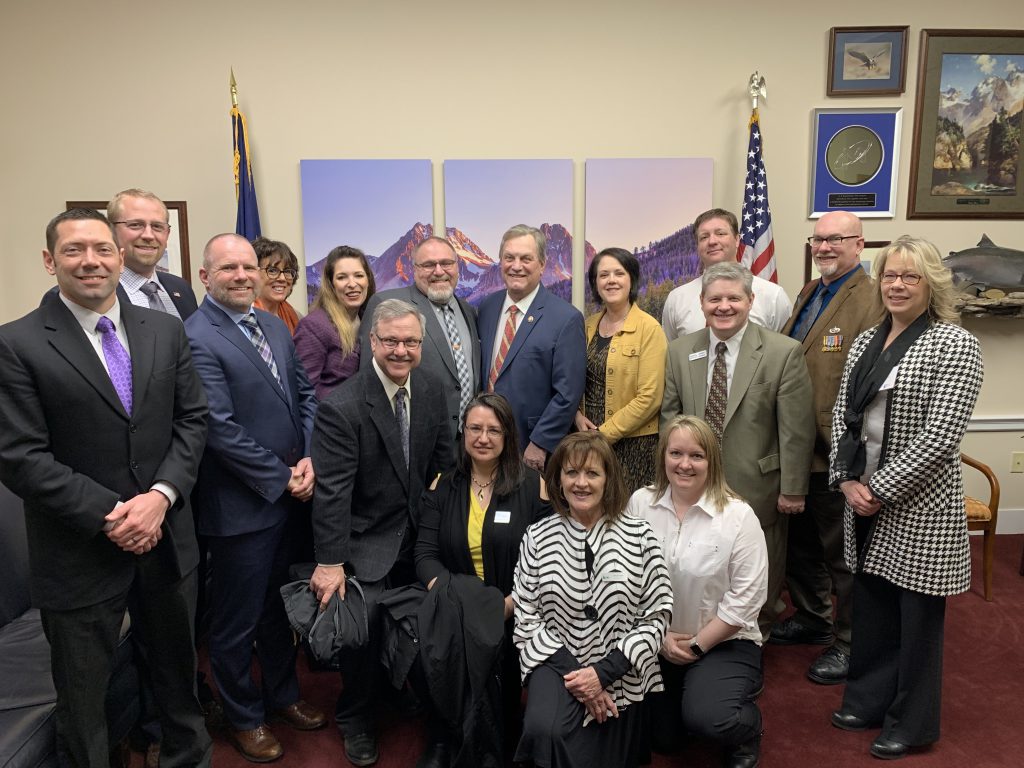

Twelve years ago, Shelley High School business educator Pam Kantack was a big proponent of every student needing a college degree—until she saw what CTE programs were doing for students.
“I didn’t really understand what CTE was until I got into the schools,” said Kantack. “There are all these different pathways that allow students to explore what they love without spending a lot of money to get the training they need to enter the workforce.”
Since then, Kantack has been an ardent supporter of CTE programs and was eager to help more administrators, teachers, parents, and students see their value. So when she received an email from the Idaho Division of Career Technical Education (IDCTE) promoting its Leadership Institute program in 2017, she thought it would be a good way to champion CTE—and achieve her goal of becoming an administrator.
“I didn’t think I would be accepted, but I thought our school could benefit from more leadership on the CTE side, so I applied anyway,” said Kantack.
To her surprise, she was accepted. Over the next three years, Kantack balanced her responsibilities as a business educator with the requirements of the Leadership Institute program, which included attending seminars on state and national CTE policy, completing the Idaho Association of School Administrators Project Leadership program, creating a professional development plan to obtain an Idaho CTE administrator’s endorsement, and attending state and national meetings to expand her knowledge of CTE. Kantack said the state and national policy initiative was the most helpful of all the opportunities Leadership Institute provided.
“My overall goal was to make CTE a priority in our district, but I didn’t know how or who to talk to,” said Kantack. “Through Leadership Institute, I gained the confidence to talk to legislators, tell them what was going on in our classrooms, and ask for their support.”
Pam Kantack
Though the time commitment was at times intense, Kantack says the most challenging thing about the program was developing confidence in her leadership skills.
“It probably took until the second year of the program for me to realize I had the capability to be a leader, accept that power, and move forward with it,” said Kantack. “It was truly life-changing. I didn’t consider myself a leader before Leadership Institute, but my leadership qualities have tripled since I started.”
Kantack used her newfound confidence to ask her administration if she could teach part-time and spend the rest of her time serving as the school’s CTE administrator; he agreed. Kantack has also used what she learned through Leadership Institute in her new role as president-elect of Career Technical Educators of Idaho, the professional association for career technical educators, administrators, and stakeholders in Idaho.
Now that Kantack has graduated from Leadership Institute, she’s more driven than ever to elevate the perception of CTE and advocate for a career technical school in the Shelley School District. “Now everybody in my school knows what CTE means, and they respect it,” said Kantack. “When people see what’s going on and what we’re producing, it’s making a difference.”
Hard work, determination, translate into career in phlebotomy

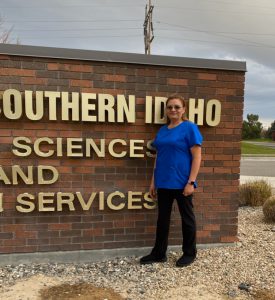
Maria Lopez always knew she wanted to be a nurse. In Mexico City, where she lived before coming to the United States, she even began taking classes. While Lopez didn’t complete her studies, she never abandoned her dream. So when Lopez saw a flyer at the Mexican store advertising the Integrated Certified Nursing Assistant (I-CNA) course at the College of Southern Idaho (CSI), she knew this was an opportunity to make her dream a reality.
At CSI, the I-CNA program is offered through a partnership between its College and Career Readiness (CCR) and Workforce Development Center programs and the Health Science and Human Services department. It is designed to help non-native English speakers learn or improve their English while pursuing their CNA certification. Participants include English-language-learning U.S. citizens, refugees, immigrants, and foreign nationals from various national backgrounds, including countries in Africa, the Middle East, Asia, and Latin America.
“Because the program integrates English language and civics instruction into the standardized CNA curriculum, it takes a whole semester to complete, as opposed to the eight weeks of the general population version of the CNA class at CSI,” said Philip Valenta, industry training coordinator for CCR. “Otherwise, our students are completing the same clinicals and exams as the students of any other CNA section offered on campus.”
The I-CNA program provides a dedicated English Language Acquisition (ELA) instructor to help students improve their language skills and support them during their CNA instruction. The program also includes support outside the classroom, including securing funding assistance, figuring out transportation and childcare options, and creating study groups. And because the cohorts are small—about 10 students are served each semester—CCR can follow up with program graduates to see how they’re doing, personally and professionally. The program was perfect for Lopez, so she enrolled on Jan. 10, 2021.
Lopez, who has been in the U.S. for 26 years, found the customer service and guest relations skills she acquired working at a casino, first as a housekeeper, then as a desk clerk, translated well to being a CNA. But studying medical terminology in her second language proved to be particularly challenging. Fortunately, her children, ages 17, 35, and 38, have been supportive and encouraging.
“They’ve been incredible. I’m 56, so going back to school was a little hard, especially at my age. But when I begin something, I don’t stop,” said Lopez. “Sometimes, I’d take a picture of something I didn’t understand and send it to my daughter-in-law and have her explain it to me.”
Lopez also studied with her youngest daughter.
“She’ll be graduating early in February, and she wants to be a CNA, too,” said Lopez. “She helps me a lot, and I always practice with her.”
In addition to support from her family, Lopez also appreciates the help she received from her instructors at CSI.
“I had the best teachers. Every patient is different, and they showed me so many ways to get the job done and make sure every patient has a good experience,” said Lopez. “They made everything look so easy, but they also made me feel like I could do it. They were so encouraging.”
Maria Lopez
Through hard work and determination, Lopez finished the I-CNA program in June and passed her exams in August. After getting hired as a CNA at St. Luke’s Magic Valley in September, Lopez decided to take the 80-hour phlebotomy course at CSI, which she completed in December. She continues to improve her skills—in both nursing and English.
“When I was taking the CNA course, I had to read some chapters four or five times in English and one or two times in Spanish. I even downloaded a translation app on my phone to help me,” said Lopez. “But now, in my phlebotomy class, I need minimal translation to understand.”
Lopez loves her new job, but she hasn’t forgotten the importance of customer service and hard work. “It doesn’t matter what language you speak,” said Lopez. “It matters how you do your job, how you handle difficult situations, and how you choose to care for people.”
Relationships, certifications lead to 100% job placement for Diesel Technology program
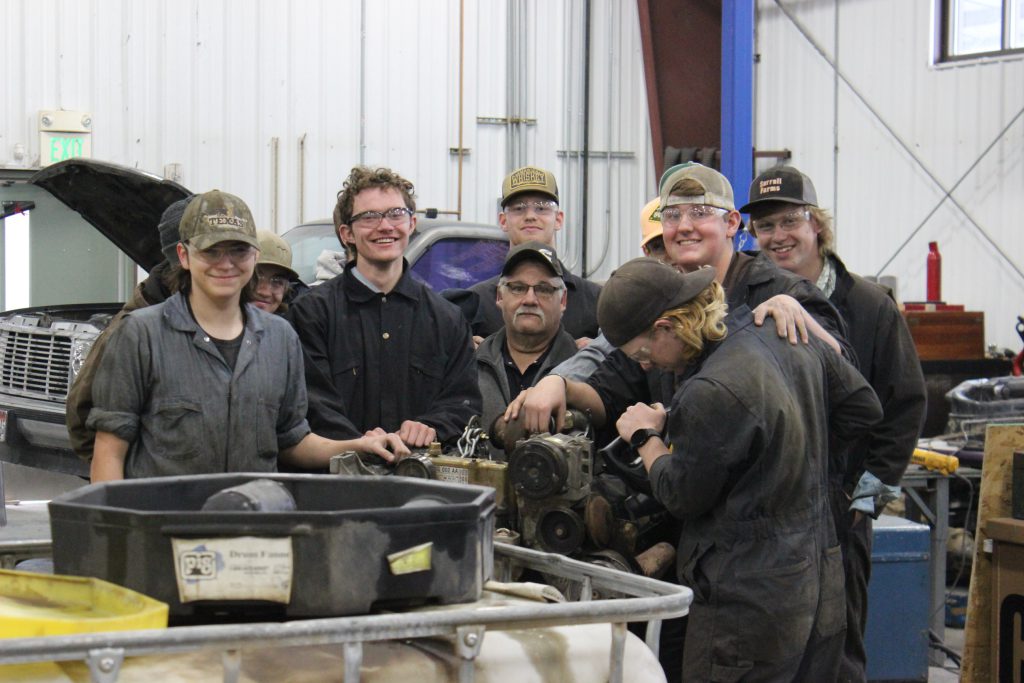
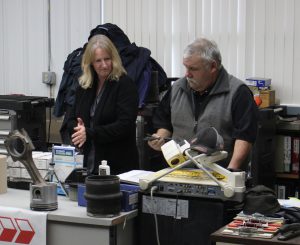
Diesel mechanic John Montana knows firsthand how difficult it is to find skilled workers, especially for in-demand professions. In fact, his inability to find and hire qualified workers is what drove him to become a teacher in the first place.
“I couldn’t hire decent help,” said Montana. “I was training new employees on the job anyway for about 10 or 11 years, so when Canyon-Owyhee School Service Agency’s (COSSA) old diesel technology teacher retired in 1999, I figured I’d give teaching a try.”
Though Montana started teaching part-time, he soon discovered he loved working with the kids and was teaching full-time by his second year. In the two decades since, Montana has cultivated relationships with about a dozen farm implement companies, several of whom employ Montana’s former students. These relationships benefit students and businesses alike—in many ways.
First, industry partners like John Deere, Kenworth, Peterbilt, Agri-Service, Caterpillar, and Mountain View Equipment are always willing to drop off equipment and provide opportunities for students to develop their skills via job shadowing and internships. They know they’ll be able to hire skilled workers from the talent pool Montana produces, so they’re willing to help his students develop career readiness skills by conducting mock job interviews or reviewing student resumes.
Second, industry partners provide additional feedback about new workers’ skills and what needs to change or be updated in the program to prepare students for their careers. This also helps ensure Montana himself stays current.
“That’s one positive thing about these kids staying local; they’re an excellent reference for me,” said Montana. “I don’t get to work out in the field like I used to, so I bounce stuff off my former students all the time. I know I can call any of them up and ask, ‘What have you run across?’ or ‘We’ve got this truck in here that’s doing this and this; have you seen anything like that?’”
Most importantly, these relationships have resulted in 100% job placement over the past 14 years.
“Because the program teaches to NATEF standards, students can earn industry-recognized certifications in electrical engines, transmissions, engine repair, brakes, and preventative maintenance,” said Montana. “Students can also earn their OSHA 10 card and SP2 Safety and Pollution Prevention training certificates while still in high school. That means students may not need a lot of on-the-job training after they graduate.”
This is a huge advantage to not only students but their employers as well.
“If there are 50 applicants for a job and you have these certificates—especially the safety certificates—you’ll move to the top of the list because it cuts down on the number of hours an employer has to train you, and you can get right to work,” said Montana.
Patricia Frahm
COSSA’s principal, Patricia Frahm, says the importance of this foundation can’t be overstated. “If a student walks out of a CTE program with these certifications, they can walk into a job immediately, and if they decide to go on to college, it gives them a skill they can use to pay their way through school,” said Frahm. “They also learn work ethic and accountability in the process—things that can help them for the rest of their lives.”
High school fire program helps fill workforce need in the Portneuf Valley


When veteran firefighter Mark Brood agreed to do a presentation on volunteer firefighting at Pocatello High School in 2015, he had no idea where it would lead.
“Right after my presentation, I got hauled down to the principal’s office,” said Brood. “Lisa (Delonas) told me they had a first responder academy, but they didn’t have an EMT or a fire component. She asked if I would be interested in helping get it up and running. I guess it was a case of being in the right place at the right time.”
In his 29 years in the fire service, Brood had trained a lot of new firefighters, so he was up for the challenge. As an active fire chief with the North Bannock Fire Department, he could also rely on his industry connections to establish the program. Fortunately, Brood received much support from Superintendent Dr. Douglas Howell, the school board, the school district, and the fire community. Throughout Eastern Idaho, donations poured in, including turnouts (the protective gear worn by firefighters) from the city of Chubbuck, various equipment from the city of Pocatello, and fire hoses from the Idaho Falls Fire Department.
One of the reasons the community rallied around the program is the growing need for first responders and the fact that so many small communities in Idaho rely on the service of volunteer firefighters.
“In these communities, shopkeepers, farmers, ranchers, and neighbors just drop whatever they’re doing when the bell rings and hop on the fire truck as it goes by,” said Rhonda Naftz, career technical education administrator for School District No. 25. “It’s like training them to fulfill their civic duty. This CTE program can bring this service to smaller communities.”
The Pocatello/Chubbuck School District renovated a building to house the career technical school program and purchased a retired fire engine using Perkins funds. Brood built all the other props necessary for the program, so it was ready to accept its first students when the 2016-2017 school year began.
“When you walk into the classroom, I wanted it to feel like you were walking into a fire department,” said Brood. “I teach to International Fire Service Accreditation Congress (IFSAC) standards. We start each class with the textbook and didactics, then get into the skill work. We try to do everything just like in a fire department, including breaking the class into three platoons, each with its own captain.”
Every day, Brood’s students go through all the equipment to make sure it’s ready and even participate in timed drills, like putting on all their gear in under three minutes. Just like in a real fire department, they have competitions to see which platoon finishes first. Students also can assist on calls, do a ride-along and practice practical skills towards the end of the program.
“The need for first responders is only going to increase as Idaho’s population grows, and this program helps to fill some of that need,” said Brood. “Now that we’re six years into the program, we’re starting to get success stories, which is really cool. I love it when you see a student achieve their goal, or even better, achieve something they didn’t think they could do.”
Mark Brood
Everything about the program is designed to ensure students are prepared to be first responders upon graduation. For example, Brood follows the Candidate Physical Ability Test curriculum, the recognized standard for measuring an individual’s ability to handle the physical demands of being a firefighter. Also, all students earn the National Heart Association CPR for Healthcare Providers certification. Finally, most students take the firefighting course as juniors and the EMT course as seniors because most fire departments require EMT certification.
Upon completion, students have received training to earn their IFSAC and National Wildfire Coordinating Group certifications in Hazardous Materials, Extrication, and Wildland Fire. Students still have to take the industry test, which involves the use of a specialized burn trailer. Students need to be 18 and graduated from high school to complete this component; this activity is usually completed the summer following graduation.
As proof of Brood’s students’ achievements, the SkillsUSA chapter he advises swept the podium during the 2019* state competition. After graduation, many of the students begin their careers with municipal or volunteer fire departments, the Bureau of Land Management, or the U.S. Forest Service, and one student went on to graduate from the Idaho Police Officer Standards Training.
LCSC grad takes over Collision Repair Technology program
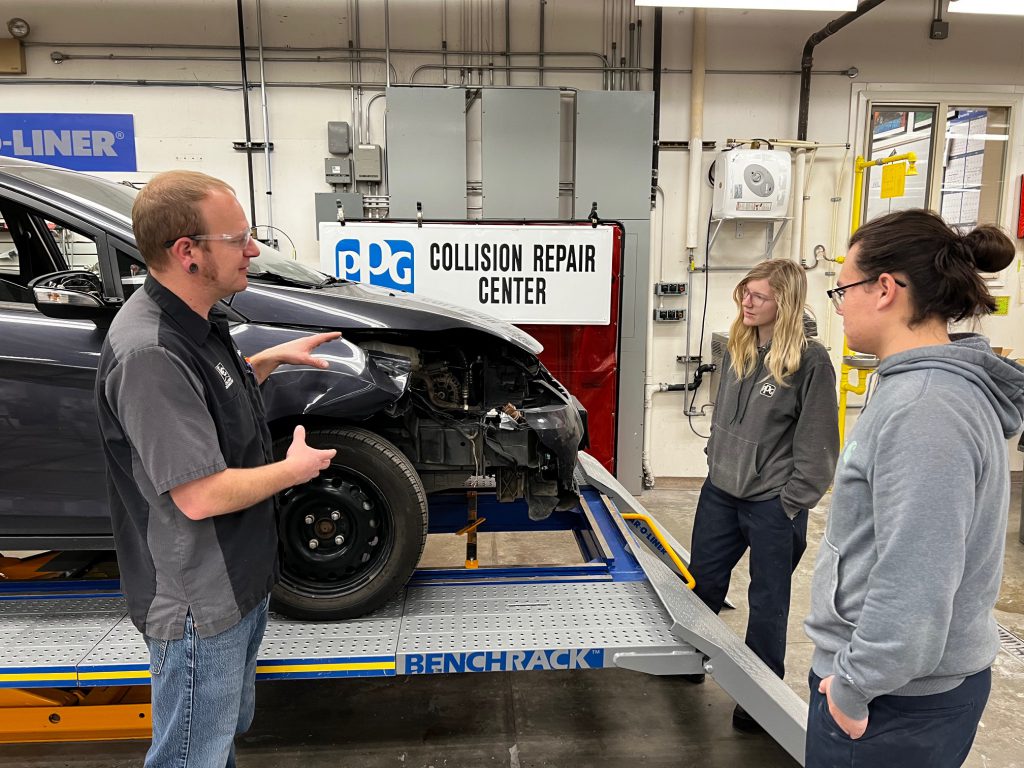

Growing up in the unincorporated town of Laclede, Idaho, Luke Thomas didn’t know what he wanted to do after high school—but he did know he loved working on cars.
“We had a neighbor who worked on cars, and he helped me restore my first vehicle,” said Thomas.
From then on, Thomas was hooked. A family friend who taught at Lewis-Clark State College (LCSC) recommended its two-year Collision Repair Technology program. The program’s reputation, hands-on application, small class size, and one-on-one time with the instructor all appealed to Thomas, who graduated with an Associate of Applied Science in 2008.
After graduation, Thomas’ career was humming along. He had his own repair shop and worked on custom restorations, but he wanted to explore a different facet of the industry. Around that time, Thomas’ professor, Clarence Griffin, decided to transition to teaching part-time, so Thomas saw an opportunity to teach in the same program from which he graduated.
“I was ready for a change and the opportunity to teach the collision program arose at the right time,” said Thomas. “It sounded like a fun way to change things up and help make a difference in the industry.”
During his first three years teaching, Thomas was grateful to be teaching alongside Griffin. And for the most part, Thomas kept the program the same as when he completed it. During the first year, core instruction is provided, and during the second year, students receive in-depth instruction in more complex systems and hands-on training in mock and customer projects.
“Because it’s a two-year program, students can go beyond just learning metal straightening or crash repairs,” said Thomas. “That means we can focus on more advanced skills, and they can get exposure to more facets of the collision repair industry. They’re qualified for a broad spectrum of industry segments by the end of the program, including some outside the collision field, like aviation refinishing, boat manufacturing refinishing, heavy trucks collision repair, custom cars, and hot rods.”
Luke Thomas
A major component of the program is completing an eight-week internship with a local shop. Many students have jobs lined up after graduation at the shop where they completed their internship, which many keep until they decide to move on. The internship allows employers to tap into a talent pipeline to fill their needed positions, which Thomas says translates into more support for the program. Body shop owners have donated vehicles, parts, and uniforms or provided scholarships for the students, and vendors will come in for demonstrations or product training.
Six years later, Thomas has found what he was looking for as a career technical educator. Teaching gave him the freedom to continue running his repair shop and custom restoration business while having more time to pursue other interests. It’s also given him a more holistic perspective of the industry he loves, deepening his appreciation for it.
Above all, Thomas says teaching has allowed him to share his passion with others. “I like seeing someone make something of themselves,” said Thomas. “It takes a lot of work to complete the two-year program, and it’s very rewarding to see a student who completed the program working in the industry and enjoying it.”
HVAC program provides seamless transition from secondary to postsecondary

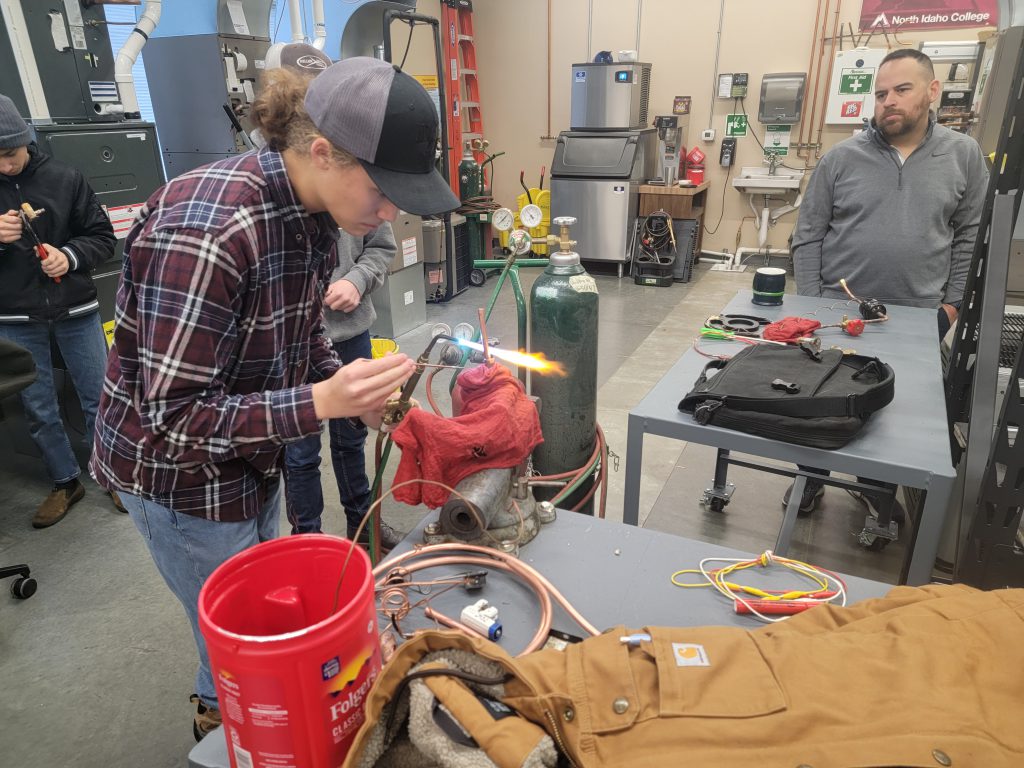
The week before the fall 2017 semester began, Sean Sater received a call from the Trades and Industry Division Chair at North Idaho College (NIC), Doug Anderson. Anderson wondered if Sater would be willing to teach the heating, ventilation, and air conditioning technician (HVAC) class; if Sater said no, the program would be shut down.
Fortunately, Sater, who has 22 years of experience in the field, knew firsthand how much the Coeur d’Alene-Spokane area needed well-trained HVAC technicians. He’d also considered cutting back his hours at HollisterStier, where he worked as a consultant, so he agreed.
“I thought it was a great way to pay it forward and help the next generation change their stars,” said Sater.
Though his first year was a baptism by fire of sorts, Sater enjoyed teaching. So when Anderson, who also served on the board of Kootenai Technical Education Campus (KTEC), asked if Sater would be interested in teaching HVAC at the secondary level the following year, he again agreed.
“I was head over heels to get a hold of them early and get them trained up right,” said Sater. “When we first sat down, we didn’t want the HVAC program to be a huge expense, so we decided it would be best to let the KTEC students use the NIC lab. It’s within walking distance, and we didn’t have to bring in more equipment, which helped us strengthen the partnership between the secondary and postsecondary programs. It was a win-win-win for the students, the schools, and the taxpayers.”
Next, Sater had to strike a balance between offering enough dual credit to make the HVAC pathway appealing to secondary students but not reducing the course load so much that students wouldn’t be considered full-time students and not qualify for financial aid once they transferred to NIC. Sater settled on offering the three-credit HVAC 165 course for his KTEC students, making it easy for them to transition to the second semester’s coursework at NIC.
Sater’s unique position at KTEC and NIC means he can ensure his students have a seamless path from secondary to postsecondary to career. And because there is such a demand for HVAC technicians, employers are eager to speak to his classes and offer opportunities for his students to job shadow or do ride-alongs with their employees.
“It gives them a chance to see if an employer’s culture fits what they’re looking for,” said Sater. “They can talk with industry professionals and see how they operate, keep their vans, and figure out if it would be a good fit—and they get paid to do so.”
Sean Sater
These interactions with employers mean most postsecondary students in their second and final semester know where they want to work and have a job lined up after graduation. The jobs Saters’ students walk into don’t exactly pay minimum wage, either.
“They’re paying $9,000 for books and tuition and can be making $52,000 a year to start, without the baggage of student debt,” said Sater. “That’s a pretty solid return on investment.”
At the end of the day, Sater loves knowing he’s setting future professionals up for success while helping to meet industry needs.
“I love the feeling of getting through to someone,” said Sater. “They might ride the struggle bus for a while, but when things come together, they learn it and burn it into their memory. It’s priceless to see the light come on.”
Student Leadership Conferences will be held in person


The Idaho Division of Career Technical Education (IDCTE) is continuing its preparation to hold all seven spring Student Leadership Conferences (SLCs) in person in 2022.
IDCTE considers all attendees’ health, safety, and well-being to be of the utmost importance. Further, we’re committed to providing a safe, productive, and welcoming environment at each event. Therefore, we’ll follow the recommendations of national, state, and local health agencies and the policies of the venues hosting our events. (A complete list of events and locations is available on our website.) Because of the rapidly changing nature of the pandemic, we reserve the right to modify policies around masking and social distancing at any time.
We’ll continue to monitor and update safety precautions as the situation changes and will work diligently to communicate any changes as they occur.
SkillsUSA Idaho earns Gold level recognition through the State Standards of Excellence Program for two consecutive years


For the second year in a row, the SkillsUSA Idaho association achieved the Gold level of SkillsUSA’s State Standards of Excellence Program.
SkillsUSA is a career technical student organization (CTSO) dedicated to improving the quality of America’s future skilled workforce through developing personal, workplace, and technical skills grounded in academics. Students participate in activities and competitive events designed to prepare them for leadership in the world of work. Membership is organized into chapters at participating high schools and postsecondary institutions; these chapters are overseen by the state association, which the State Standards of Excellence program is designed to recognize.
Now in its fifth year, the program is designed to ensure state associations have in place policies, procedures and structures that deliver a high level of service to members. This non-competitive program serves as a system to allow states to benchmark their performance and determine improvements to become the very best organization for their members.
“Achieving Gold level for two years in a row is a sign that SkillsUSA Idaho is determined not just to get back to ‘normal,’ but set an example for our members that we will emerge from the pandemic as leaders on a national level,” said SkillsUSA Idaho State Director Chet Andes.
Andrew Armstrong, CTSO manager for SkillsUSA Idaho, echoes Andes’ sentiment.
“Winning this award for two years gives me great pride in the direction of SkillsUSA Idaho. This award shows that we are committed to our membership and are fully committed and prepared to serve our chapters,” said Armstrong. “I hope this opportunity challenges our members to build strong chapters that are as excited as we are to show how amazing our Idaho members are at the national level.”
Nationally, 38 states participate in SkillsUSA. The following state associations were recognized for achieving the Bronze level of establishing a baseline for a healthy association: Arkansas, Colorado, Iowa, Nebraska, New Hampshire, North Dakota and South Dakota.
The following states moved to the next level by being recognized for achieving Silver, ensuring the sustainability of healthy association: Alabama High School, Indiana, Kentucky, Louisiana College/Postsecondary, New York High School, Utah, West Virginia and Wyoming.
The following states reached the pinnacle of achievement by completing the Gold level requirements, ensuring the continued growth of the association: Arizona, California, Florida, Georgia College/Postsecondary, Georgia High School, Idaho, Illinois, Kansas, Maine, Massachusetts, Nevada, New Jersey, New Mexico, North Carolina, Ohio, Oregon, Pennsylvania, Rhode Island, South Carolina, Texas College/Postsecondary, Texas High School, Virginia and Washington High School.
For more information about SkillsUSA, visit skillsusaidaho.com or skillsusa.org.
Idaho Division of Career Technical Education awards $3.5 million in “Building Idaho’s Future” grants to secondary and postsecondary CTE programs

The Idaho Division of Career Technical Education (IDCTE) has awarded $3.5 million in grants to expand and modernize Idaho’s secondary and postsecondary career technical education (CTE) programs to meet Idaho’s growing need for a skilled workforce. The grants were awarded to all six technical colleges and a mix of rural and urban districts statewide.
The one-time funds were made possible by the “Building Idaho’s Future” initiative, Governor Brad Little’s plan to use Idaho’s record budget surplus to provide Idahoans historic tax relief and make strategic investments in transportation, education, broadband, water, capital construction, and other critical areas.
“By investing in career technical education, we are investing in our workforce and Idaho businesses. My ‘Building Idaho’s Future’ plan is all about strengthening our state for today and the next generation of Idahoans,” said Governor Little.
CTE programs that provide state-of-the-art, hands-on training for high-skill, in-demand careers have increased in popularity.
“The intentional alignment between our secondary and postsecondary CTE programs provides for a seamless, more efficient, and cost-effective mode of continuing education. That means less time—and money—to acquire the necessary training to obtain in-demand jobs,” said Clay Long, state administrator for IDCTE. “Idaho’s employers have a hand in developing a talent pipeline catered to their needs, and our Governor and legislators can see that CTE programs help to fill the skills gap and keep Idaho competitive.”
To be eligible for funds, programs were prioritized based on alignment with regional workforce needs, demand for occupation, number of job openings, and projected growth rate.
“We wanted to make sure we were investing in occupations that are growing in demand, both to ensure employers have a skilled workforce and students can find jobs in their area of study upon completing their programs,” said Long.
In addition to granting funds for secondary and postsecondary programs, Building Idaho’s Future also provided $3 million to the College of Eastern Idaho’s FutureTech building, an 88,000 square-foot, state-of-the-art facility designed to house labs and classrooms to accommodate students in energy, environmental, and technology programs. It also provided $1.25 million for Workforce Training Centers (WTCs) to develop and deliver content, including $750,000 for training programs specific to the food processing and manufacturing industry. WTCs, which are located at Idaho’s six technical colleges, develop programs to help train or retrain employees to keep up with the needs of their employers and fill hard-to-fill positions.
“We appreciate Governor Little’s recognition of the shared level of importance of ensuring students enrolled in secondary and postsecondary programs and Idahoans already in the workforce have access to the technology, training, and equipment they need to be ready for their careers,” said Long. “It will be exciting to see how this investment in our students and workforce will help our state in the months and years to come.”
Idaho teachers, students, earn accolades at the HOSA International Leadership Conference

Four teachers and 10 students from Idaho earned accolades at the virtual HOSA International Leadership Conference held June 23-26, 2021. The conference featured general sessions, workshops, and competitive events that focused on leadership, professional, and technical skills.
Highlights included inducting Meridian Medical Arts Charter School teacher Carie Staub into the HOSA Hall of Fame. Staub, a licensed athletic trainer, teaches health sciences and sports medicine, serves as a HOSA advisor, and sits on the HOSA board of directors and the planning committee for the state leadership conference.
The HOSA Hall of Fame was created to honor and recognize individuals and companies who have rendered outstanding service to HOSA, health and biomedical science education, and the health industry. Each year, one chartered association advisor, one local advisor, one member, one alumnus and one partner is inducted into the Hall of Fame; Staub was inducted as a local advisor.
“Carie was committed to ensuring this year’s virtual State Leadership and International Leadership conferences looked and felt as normal as possible for all students during an unpredictable year,” said Stephanie Mai, Idaho HOSA state advisor. “She continually dedicates her free time to grow and develop opportunities for her own students, as well as all HOSA members. Idaho HOSA would not be the same without her profound knowledge, spirit and commitment.”
Three other Idaho teachers received recognition during the June 26 awards session:
- Blake Gaudet, Outstanding Local Advisor (Secondary), Meridian Medical Arts Charter High School, Meridian
- Rene Rambur, Outstanding Local Advisor (Postsecondary), College of Southern Idaho, Twin Falls
- Olivia Swainston, Outstanding HOSA Leader, Idaho State University, Pocatello
Idaho students also earned awards and honors at the international conference:
Postsecondary/collegiate division:
- Soraya Berry, 2nd place, Job Seeking Skills, College of Southern Idaho, Twin Falls
- Kassandra Klimes, 5th place, Dental Science, College of Southern Idaho, Twin Falls
Secondary division:
- Madison Boring, Silver Service Award (175-249.9 service hours), Canyon Ridge High School, Twin Falls
- Xavier Christy, $1,000 scholarship recipient from the Association for Career and Technical Education Health Science Education Division, Meridian Medical Arts Charter High School, Meridian
- Kyra Deville, Bronze Service Award (100-174.9 service hours), Canyon Ridge High School, Twin Falls
- Angel Dominguez, 1st place, Job Seeking Skills, Grangeville Chapter
- Hailie Goldthorpe, Silver Service Award, Mountain Home High School, Mountain Home
- Wency Suo and Karoline Yang, 6th place, Health Career Display, Boise High School, Boise
- Cynthia Zepeda, Bronze Service Award, Canyon Ridge High School, Twin Falls
“We’re really proud of our students and how well they adapted to the virtual events and competitions,” said Jessie Kellogg, Idaho HOSA manager. “We know how hard they had to work to overcome the obstacles of the past year.”
 Official Government Website
Official Government Website